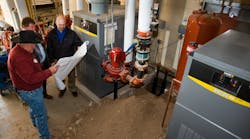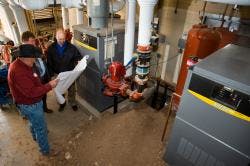Integrating electronics into mechanical systems has been - and will increasingly continue to be – a bittersweet trend in the industry. The benefits are infinite, but the challenges are daunting if dealers aren’t making an effort to grow with the technology.
As system and component efficiencies hike skyward, controls become more comprehensive and remote location access becomes the standard; technicians need more specialized training. This holds true in the residential market, but is especially important in the commercial sector. For commercial and industrial mechanical contractors, moving across the fast-paced, higher-tech terrain will mean: adapt or perish.
One firm that’s gone far beyond adaptation is ECI (Energy Control, Inc) in Rio Rancho, NM. The company has not only embraced this shift in mechanical systems, but has entirely structured around it. They’ve proven that board room thinking can translate into substantive, profitable, real-world problem-solving and growth.
As one of New Mexico’s foremost intelligent building leaders, ECI combines routinely-honed technical expertise and training with cutting-edge technology and energy efficient equipment to deliver environmental comfort, security, access, and control. They’ve made it their charter to stay on top of the newest technologies since the mid-1970s and are poised to adapt going forward as the presence and influence of electronics in the HVAC industry grow exponentially.
“Energy efficiency and controls were the focal point when ECI was formed 30 years ago,” says ECI Project Deployment Director, David Frederick. “Over the years, we morphed into a mechanical firm, all the while keeping that original focus.”
Partners for Success
“For the past decade, ECI has worked with us to keep our energy costs in check and our systems running efficiently,” says Santa Fe Energy Conservation Program Coordinator, Lisa Randall. “More recently, they’ve played a huge part in helping us achieve the goals we’ve set with our district-wide energy conservation program.”
According to Randall, the conservation program — which started in 2010 — is a speedy approach to retrofitting and updating most of the district’s 60 buildings. Facilities are undergoing renovation, new controls are going in, boilers are being replaced and solar arrays are being planned. All the while, energy and water use decreases.
But the service Santa Fe School District gets from ECI extends beyond shaving energy bills. ECI provides district-wide equipment assessment, HVAC service, a preventative maintenance program and remote water metering. “If you’re not from Santa Fe or the Southwest, you might not understand how important water metering can be,” Randall says. “Our water expense is almost double our natural gas bill.”
ECI installed water smart meters at all high-use facilities to help curb the District’s $750,000 annual expense. The meters identified a few large leaks and other problem areas immediately. After those were handled, maintenance prevented further challenges, and a variety of low-flow fixtures went in next.
“We do water audits mainly by request,” Frederick says. “We look at the meters the client has installed, their usage habits and water bills, and compare the data to other facilities in the area and around the country. Typically, it’s displayed in a gallon per square foot format, and we can easily see how the facility stacks up against others like it. Changes are made accordingly.”
Nearly every facility in the 13,500-student district has undergone – or is slated to undergo – some form of water or energy-saving improvement. The scope of the retrofits varies widely, as does the age of the buildings and mechanical systems. Most retrofits are done at a breakneck pace in order to wrap up all the work over one summer vacation.
According to the Santa Fe School District, the past two years have seen a 17.5% decrease in natural gas consumption, 9.3% drop in electric use, and 12.7% reduction in water use when compared to pre-retrofit numbers. The total operational budget savings so far is nearly $390,000.
Aspen School
One of the first facilities to go under ECI scrutiny for the Energy Conservation Program was Aspen School. The old school accounts for 80,000 of the district’s 2.3 million square feet of conditioned space. An all-out renovation took place over the summer of 2010. To ensure completion by the strict deadline, ECI kept 10-15 employees on-site for the duration of the project. The nearly-windowless, circa-1970 middle school was completely gutted and rebuilt, and turned into a K-5 school. A second phase took place a year later, when an addition was constructed to house a 6th, 7th and 8th grade academy.
“Our portion of the Aspen retrofit consisted of removing the old boilers and air handlers, installing new equipment and a new building automation system” Frederick says. “With the retrofit project and the addition going on simultaneously, it was a real challenge at times.” With a combined capacity of 4.8 million BTUs, two Laars Rheos boilers heat the renovated portion of the school with VAV (variable air volume) boxes. The modulating, condensing boilers boast up to 98% efficiency; more than enough to appease even the stingiest of Energy Conservation Program staff. Seven, 15-ton, and two 30-ton AAON rooftop units cool the structure.
“People hear ‘New Mexico’ and automatically think it’s always 100 degrees here,” Randall says. “Not the case. We’re at about 7,000 feet above sea level here. Although it’s dry, we’re more of a mountain city than a desert city, from a heating standpoint.” Average annual lows in Santa Fe range from 18 to 55F, and the highs are between 43 and 86F.
“The heat load at the Aspen School is around 2,400 MBH,” Don Swick, PE, with Design Build ECI, says. Swick was the engineer for the entire mechanical portion of the Aspen retrofit.
Carlos Gilbert School
“All the buildings in the district use a 72F target,” Swick says. “There’s a three-degree ‘dead-zone,’ meaning that in the summer, indoor temperature will reach 75F before the AC turns on, and 69F in winter before the system calls for heat.”
In the Santa Fe Historic District, the Carlos Gilbert School faced its own set of challenges. The 83,000 sq.ft. building was entirely gutted and rebuilt, but every change to the facility needed to be approved by the Historic Review Board.
Six ECI technicians pulled out old cast-iron boilers and pneumatic controls. The old boilers came out in pieces, but there was no simple way to bring the new units into the basement mechanical room. After careful consideration, a portion of a block wall was removed so that the boilers could be craned in. Luckily, the building remodel happened to call for the removal of the same wall.
Most ECI hydronic installations have a supply temp between 130-180F, with a reset schedule. Carlos Gilbert is no exception; two, 750 MBH Laars Pennant boilers supply 180F water to a four-pipe unit vent system. “We’ve standardized on Laars boilers,” said Frederick. “The quality of the product and unparalleled support from Boyd Engineering Supply, made the decision easy. I don’t know why more dealers don’t do it; we can be much more proficient in service and maintenance utilizing only one line.”
Boyd Engineering Supply, in Albuquerque, supplies almost all the HVAC components used by ECI. 4 Seasons Engineering Inc., in Albuquerque, did the design work for historic building. “We have in-house engineers, but sometimes – depending on the project – we’ll outsource systems,” added Frederick.
Amy Biehl School
The district’s new flagship facility —the Amy Biehl Community School — is in a class of its own. Named after the American social activist who, in 1993, was murdered in South Africa while working to eliminate racial segregation and apartheid in that country. Her family went on to start the Amy Biehl Foundation Trust in an effort to reduce violence there. Biehl attended Santa Fe High, so the district found it appropriate to honor her with the building’s dedication. LEED Gold status is currently being sought.
The school acts as the beta test site for the water monitoring equipment that the district seeks to install in all facilities. Live water and natural gas usage data is posted online for students and community members to view. On the same website, real-time photovoltaic electric production data will be accessible, once the school’s photovoltaic is complete, which will provide up to 65 kW. Solar panels weren’t the only green technology to make list during the design phase. What’s a super-green school without geothermal HVAC? ECI drilled and fused the large exchange field needed to serve 160 tons of geothermal heat pump equipment.
“The Amy Biehl project does a good job of showcasing our specialty,” Frederick says. “We’re strictly commercial and industrial, and energy efficiency is always our main design criterion.” The school also puts ECI’s other talents to good use, like security and high-tech building automation controls. “When the economy downturned, we saw the private sector projects taper off, so we’re glad to have the work that comes from Santa Fe School District,” he continues. “Hopefully, the savings from renovation projects like Santa Fe’s are going to gain more recognition, validating the expense for quality installations.”
The engineers and technicians at ECI aren’t the only ones working to bring the school district energy and water savings. Everyone in the district - from students to staff – is doing their part. The district has a list of expectations for people at their facilities which include things like using fluorescent light bulbs, keeping doors and windows closed during heating and cooling seasons, unplugging appliances daily, double-siding copies, and reporting energy and water waste.
“Every effort we make, however big or small, makes a difference,” said Randall. “The less we spend on utilities, the more stable the budget is for the people working directly with students.”
Dan Vastyan is a writer and account manager for Common Ground, a trade communications firm based in Manheim, PA. He can be reached at 717/664-0535, or at [email protected].








